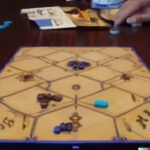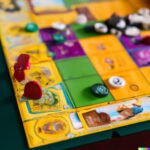Are you ready to delve into the captivating world of Root Board Game? This comprehensive strategy guide will provide you with all the essential knowledge and tips you need to master this popular tabletop game. Whether you’re a newcomer to the game or a seasoned player looking to enhance your skills, this guide is designed to help you navigate through the complexities of Root Board Game and develop winning strategies for each faction.
Root Board Game is a highly asymmetric game set in a woodland filled with anthropomorphic animals vying for control. Each faction possesses unique abilities, goals, and playstyles, making it crucial for players to understand the intricacies of each faction in order to succeed. With our detailed breakdown of the different factions, you will gain valuable insights into their strengths, weaknesses, and optimal strategies.
In addition to exploring the factions, we will also emphasize the overarching importance of strategy in Root Board Game. From grasping key concepts and mechanics to building winning tactics for each faction, this guide aims to equip you with the knowledge and skills necessary to outmaneuver your opponents on the board. So grab your favorite faction’s player board, make yourself comfortable, and let’s embark on this journey into the captivating world of Root Board Game strategy.
Understanding the Factions in Root Board Game
In the Root board game, each faction has its own unique abilities, strengths, and weaknesses. Understanding these factions is crucial in developing a winning strategy. Here are the main factions and their characteristics:
- Marquise de Cat: The Marquise de Cat faction is focused on building and controlling clearings on the board. Their strength lies in their ability to establish dominance over the map through building workshops and sawmills to produce resources.
- Eyrie Dynasties: The Eyrie Dynasties faction relies on a leader’s decree deck to take actions throughout the game. They can quickly expand their presence by building roosts but must carefully manage their decrees to avoid falling into turmoil.
- Woodland Alliance: The Woodland Alliance uses sympathy tokens to spread rebellion across the map. They thrive in situations where there is instability as they can incite revolts and create chaos for other factions.
- Vagabond: The Vagabond is a single character that operates independently of other factions. They move around the board completing quests and building relationships with other players, gaining points through their interactions.
As you can see, each faction offers a different playstyle, making it essential to understand not only your chosen faction but also those of your opponents when formulating your strategy for victory. Each faction’s strengths and weaknesses influence how they interact with others during gameplay, which ultimately impacts your approach as well.
The Importance of Strategy in Root Board Game
When it comes to the Root board game, having a solid strategy is crucial for success. With its asymmetrical gameplay and unique faction abilities, understanding and implementing the right strategy can make all the difference in whether you emerge victorious or fall short. Here are some key reasons why strategy plays such an important role in playing Root.
1. Asymmetrical Gameplay: One of the defining features of Root is its asymmetrical gameplay, where each faction has its own set of rules, abilities, and victory conditions. This means that a one-size-fits-all approach simply won’t work. Each faction requires its own specific strategy tailored to maximize its strengths and exploit its opponents’ weaknesses.
2. Strategic Decision-Making: From deciding which actions to take on your turn to where to place your forces and how to interact with other players, every decision in Root can have a significant impact on the outcome of the game. A strong strategic mindset is essential for weighing the risks and rewards of each choice and making decisions that will ultimately lead to victory.
3. Adaptability: In Root, no two games are ever the same due to the constantly shifting dynamics between factions and players. Having a solid strategy is important, but being adaptable and able to pivot when necessary is equally crucial. Being able to adjust your strategy based on changing circumstances is key to staying ahead in the game.
Key Concepts and Mechanics in Root Board Game
Root is a complex and engaging board game that is known for its unique asymmetrical gameplay. In order to fully understand the game and develop winning strategies, it is essential to grasp the key concepts and mechanics that form the foundation of Root.
One of the central mechanics of Root is its asymmetric gameplay, where each faction has its own set of abilities, goals, and play style. This means that players must not only understand their own faction’s strengths and weaknesses, but also have a good grasp of how the other factions function in order to anticipate their moves and counter their strategies.
This adds an extra layer of depth and complexity to the game, making it crucial for players to carefully consider every decision they make.
Another important concept in Root is the use of clearings and suits. Clearings are the geographic areas on the game board, each featuring different types of terrain such as forests or mountains. Suits are represented by different types of creatures (cats, birds, mice, rabbits) which correspond to specific clearings on the board. Understanding how these clearings and suits interact with your faction’s unique abilities is crucial for developing effective strategies and gaining control over key areas of the board.
Lastly, crafting an effective overall strategy requires a deep understanding of turn order and action selection in Root. Players must carefully consider which actions to take during their turns based on their faction’s capabilities as well as the current state of the game board. This requires forward thinking and adaptability as players navigate through shifting alliances, battle for control of regions, and strive to achieve their individual faction objectives.
| Concepts | Mechanics |
|---|---|
| Asymmetric gameplay | Factions with unique abilities |
| Clearings and suits | Different terrain types |
| Turn order and action selection | Strategic decision-making |
Building a Winning Strategy for Each Faction
In Root, each faction has its own unique abilities, strengths, and weaknesses that require different approaches and strategies in order to be successful. Understanding the intricacies of each faction is crucial in order to build a winning strategy for the game.
Know Your Faction
Before diving into the game, take the time to thoroughly understand the faction you have chosen to play. Each faction has specific goals and abilities that should dictate your strategy.
For example, if you are playing as the Marquise de Cat, your focus may be on building and maintaining a strong presence on the board through crafting buildings and recruiting warriors. On the other hand, if you are playing as the Woodland Alliance, your strategy may revolve around spreading sympathy tokens and inciting revolts.
Adaptability Is Key
While it’s important to have a set strategy in mind for your chosen faction, it’s equally vital to remain flexible and adaptable based on how the game unfolds. The ever-changing dynamics of Root mean that your initial plans may need to be adjusted based on other player’s actions, the state of the board, and unforeseen circumstances. Being able to pivot and adapt your strategy as needed can often make the difference between victory and defeat.
Playtest and Learn From Experience
The best way to truly understand how to build a winning strategy for each faction in Root is through experience. Take every opportunity to playtest different approaches with each faction and make note of what works well and what doesn’t. Learning from both victories and defeats will provide valuable insights that can be applied when developing future strategies. Additionally, observing how other players approach their respective factions can offer valuable lessons that can contribute to your own strategic development.
Tips and Tricks for Mastering Root Board Game
Understanding the Importance of Timing
In the game of Root, timing is everything. Knowing when to strike, when to build, and when to lay low can make all the difference in your success. Each faction has its own unique rhythm and tempo, and understanding this timing can give you a significant advantage.
For example, as the Marquise de Cat, you want to expand your presence on the board quickly, while as the Vagabond, you may want to take a more cautious and opportunistic approach. By paying attention to the ebb and flow of the game, you can make strategic decisions that will propel you towards victory.
Creating Diplomatic Alliances
One of the most intriguing aspects of Root is its potential for negotiation and alliances. Strategic alliances can provide you with much-needed support or resources at critical moments in the game. However, it’s important to remember that alliances are often temporary and can shift unexpectedly.
Keeping track of who your friends are (and who they’re not) is crucial for maintaining control over the board. Learning how to negotiate effectively and form advantageous partnerships can elevate your gameplay and give you an edge over your opponents.
Adapting Your Strategy
Flexibility is key in Root. The game is dynamic, with constantly changing circumstances that demand swift adjustments from players. Your initial strategy may need to be tweaked as new opportunities or threats arise during gameplay.
Whether it’s adapting your plans based on card draws or reacting to unexpected moves from other players, being able to pivot your strategy on the fly can be a game-winning skill. Remember that no strategy is foolproof – being open to adaptation and thinking on your feet will serve you well throughout the game.
By mastering these tips and tricks for Root board game strategy guide, you’ll be better equipped to navigate the complexities of this rich and engaging game, regardless of which faction you choose to play.
Expanding Your Knowledge With Advanced Strategies
Once you have mastered the basics of Root Board Game and have a good understanding of the factions, it’s time to delve into advanced strategies. Advanced strategies can help you take your gameplay to the next level and give you an edge over your opponents. To truly excel at Root Board Game, it is essential to be familiar with these advanced tactics and implement them effectively during gameplay.
One advanced strategy that can greatly impact your success in Root Board Game is understanding the intricacies of asymmetrical play. Each faction in the game plays differently from one another, with unique abilities and goals.
To excel in Root Board Game, players must learn to master their chosen faction’s abilities while also understanding how they interact with other factions on the board. This requires a deep understanding of each faction’s strengths and weaknesses, as well as an ability to adapt to changing circumstances on the board.
In addition to mastering asymmetrical play, knowledge of area control and resource management is crucial for advanced players of Root Board Game. Players must learn how to effectively control areas of the game board while efficiently managing their resources in order to outmaneuver opponents and achieve victory. Implementing advanced tactics in area control and resource management will elevate your gameplay, allowing you to make strategic decisions that can sway the outcome of the game in your favor.
| Advanced Strategy | Description |
|---|---|
| Asymmetrical Play | Understand each faction’s unique abilities and how they interact with others. |
| Area Control | Learn how to effectively control areas of the game board. |
| Resource Management | Efficiently manage resources for strategic decision making. |
Resources and References for Further Learning About Root Board Game Strategy
In conclusion, the Root Board Game Strategy Guide serves as a comprehensive resource for players looking to improve their skills and understanding of the game. With an introduction to the game, an exploration of factions, and an in-depth look at strategy and key concepts, this guide provides a solid foundation for aspiring players. Understanding each faction’s strengths and weaknesses is crucial in building a winning strategy, and the guide offers valuable tips and tricks for mastering the game.
Moreover, the guide goes beyond basic strategies by delving into advanced tactics, allowing experienced players to expand their knowledge and take their gameplay to the next level. By providing resources and references for further learning, such as online forums, community discussions, and supplemental reading materials, this guide empowers players to continue honing their skills even after they have mastered the basics.
Frequently Asked Questions
How Do You Win at Root Board Game?
Winning at Root Board Game requires understanding the unique abilities and strategies of each faction, gaining control of clearing, and scoring victory points through various actions. It also involves adapting to the changing dynamics of the game and effectively balancing offense and defense.
Is Root Board Game Difficult?
Root Board Game can be seen as difficult for some players due to its asymmetric gameplay, where each faction has distinct rules and win conditions. This requires a deep understanding of not only your own faction but also the abilities and potential strategies of other factions in order to effectively compete.
Is Root an Easy Game to Learn?
Root is not considered an easy game to learn, primarily due to its asymmetric nature and the need to understand the rules, abilities, and strategies of multiple different factions. The learning curve can be steep for new players, but with patience and practice, it becomes more manageable.

I love playing all kinds of games – from classics like Monopoly to modern favourites like Ticket to Ride.
I created this blog as a way to share my love of board games with others, and provide information on the latest releases and news in the industry.





